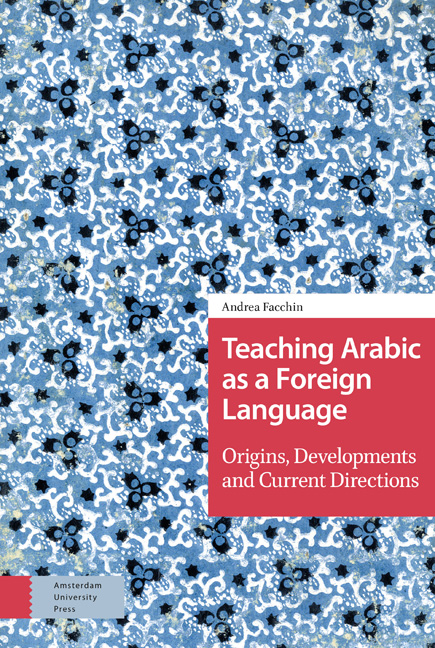Book contents
- Frontmatter
- Contents
- Acknowledgments
- Transliteration
- List of Abbreviations
- Arab World Map
- Introduction
- 1 The Historical Background
- 2 The Birth of a New Branch
- 3 Growth (1970s)
- 4 Development (1980s)
- 5 New Challenges (1990s)
- 6 In the Twenty-first Century (2000-2010)
- 7 The Present Period
- Conclusions
- List of Events
- A TAFL Who's Who (1958-2018)
- TAFL Institutes (1958-2018)
- Tables
- Bibliography
- Index
4 - Development (1980s)
Published online by Cambridge University Press: 21 November 2020
- Frontmatter
- Contents
- Acknowledgments
- Transliteration
- List of Abbreviations
- Arab World Map
- Introduction
- 1 The Historical Background
- 2 The Birth of a New Branch
- 3 Growth (1970s)
- 4 Development (1980s)
- 5 New Challenges (1990s)
- 6 In the Twenty-first Century (2000-2010)
- 7 The Present Period
- Conclusions
- List of Events
- A TAFL Who's Who (1958-2018)
- TAFL Institutes (1958-2018)
- Tables
- Bibliography
- Index
Summary
The meetings on Teaching Arabic as a Foreign Language organized in the Arab world at the end of the 1970s represented a great impetus for the subject. These conferences had a positive effect on the following decade, which was characterized by a proliferation of activities. In this light Saudi Arabia held a leading role in the field of TAFL: Mecca, Riyadh and Medina became the centers of current projects, research units, publications and talks.
This trend was also confirmed from a political point of view. In fact, two landmark occasions opened a window for Saudi Arabia's leadership ambitions in the region. The first was the exclusion of Egypt from the Arab League after the Egyptian president Anwar al-Sādāt and the Israeli prime minister Menachem Begin signed the Camp David Accords in 1978, and the Egypt-Israel Peace Treaty the year after. The second event was the collapse of the Pahlavi regime in Iran, which was considered the most favorable ruling power in the region by the United States.
The dream of leadership kept Saudi Arabia busy during the whole decade or at least until Egypt reentered the Arab League in 1989 with a new president, Ḥusnī Mubārak, elected in 1981. Nonetheless, from the beginning of the 1980s the region once again started to lose its stability. In 1980 the war between Iran and Iraq was put under the spotlight by the mass media, to such an extent that less attention was paid to the Arab-Israeli conflict and the question of peace in the Middle East. In 1982, King Ḫālid (Khaled) died and Crown Prince Fahd accessed the throne. In the first years of his tenure (1982-2005), Saudi Arabia saw an increasing number of foreigners entering the country both for work and study purposes. In 1985, the population of foreign origin was estimated at around 4 million, mainly coming from other Arab states (i.e., Egypt, Lebanon, Palestine, Syria, Jordan) and Southeast Asia (cf. Al-Rasheed, p. 197). The number of students entering university also increased and there was a considerable flow of non-Arab Muslims from Asia and Africa requesting Arabic language training.
In this time span, the Arabic language gradually crossed its traditional boundaries, since it became the official language of organizations like the United Nations, the African Union, UNESCO, the World Health Organization (WHO), and the Food and Agriculture Organization (FAO).
- Type
- Chapter
- Information
- Teaching Arabic as a Foreign LanguageOrigins, Developments and Current Directions, pp. 87 - 122Publisher: Amsterdam University PressPrint publication year: 2019



